NCERT Solution For Class 10, Maths, Chapter 5 Arithmetic Progressions, Exercise 5.3 solutions given below which is very important. Students of Class 10 maths first should learn all the basic formula and then practice all the exercise given. Class 10 maths chapter 5 ex. 5.3 is well explained in easy format.
Table of Contents
Toggle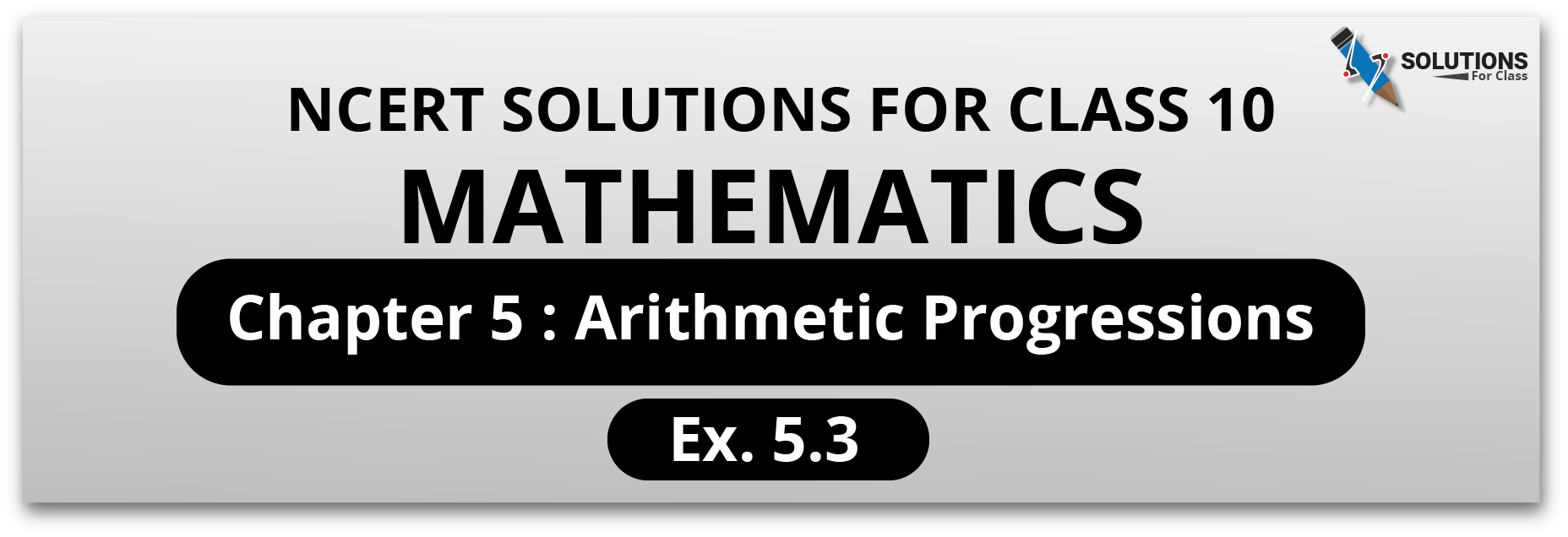
Class 10, Maths, Chapter 5, Exercise 5.3 Solutions
Q.1. Find the sum of the following APs:
(i) 2, 7, 12, . . ., to 10 terms.
(ii) –37, –33, –29, . . ., to 12 terms.
(iii) 0.6, 1.7, 2.8, . . ., to 100 terms.
(iv) $\frac{1}{15},\frac{1}{12},\frac{1}{10},…..$ to 11 terms.
Ans:
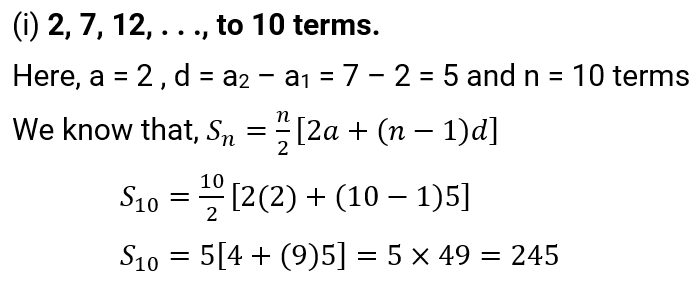
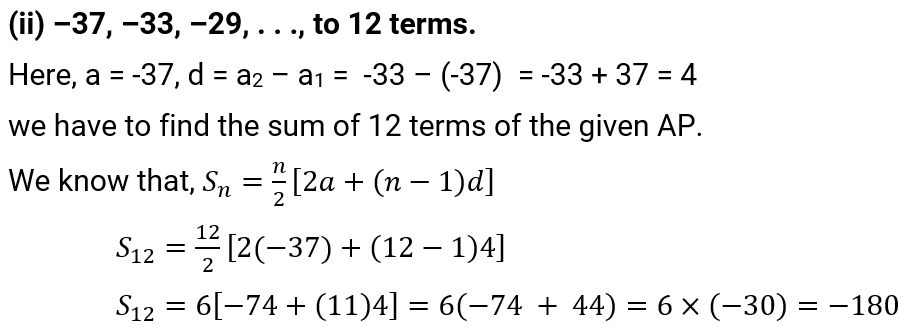
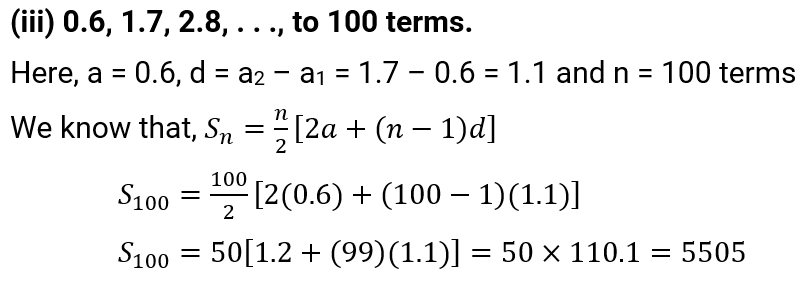
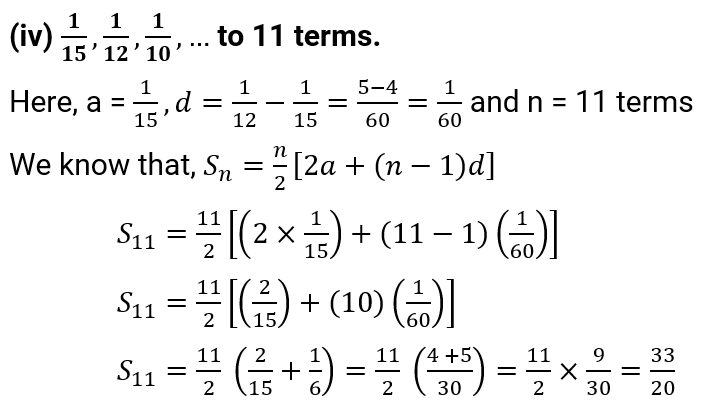
Q.2. Find the sums given below:
(i) 7 + 10$\frac{1}{4}$ + 14, …… + 84
(ii) 34 + 32 + 30 + . . . + 10
(iii) –5 + (–8) + (–11) + . . . + (–230)
Ans:
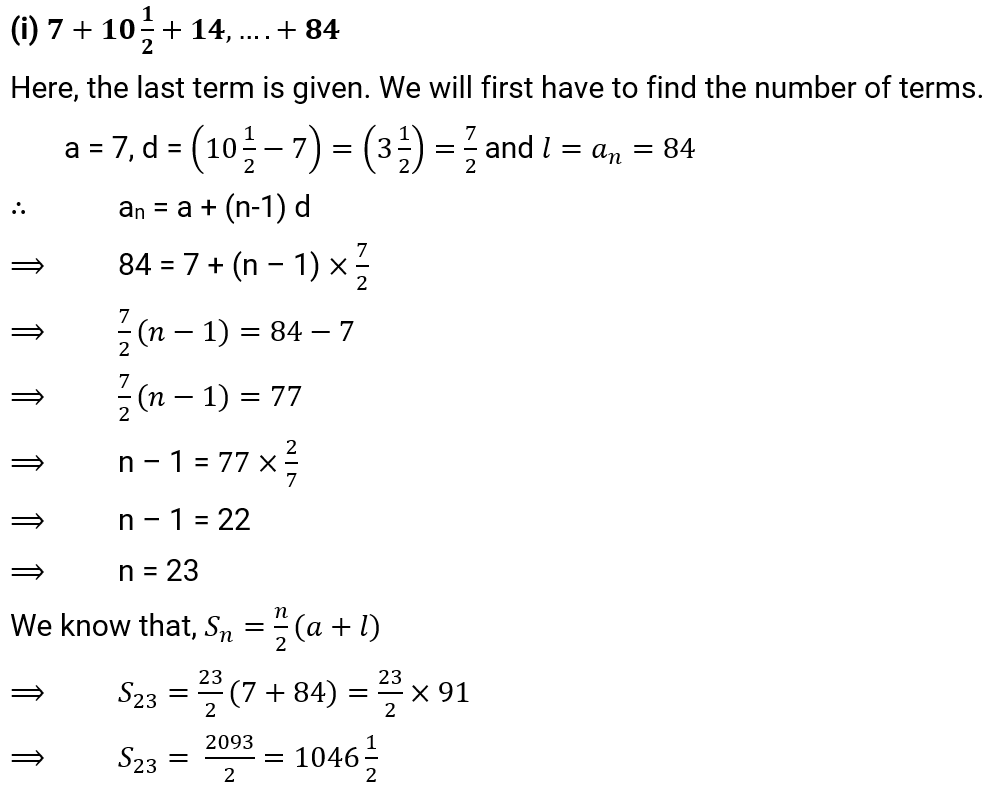

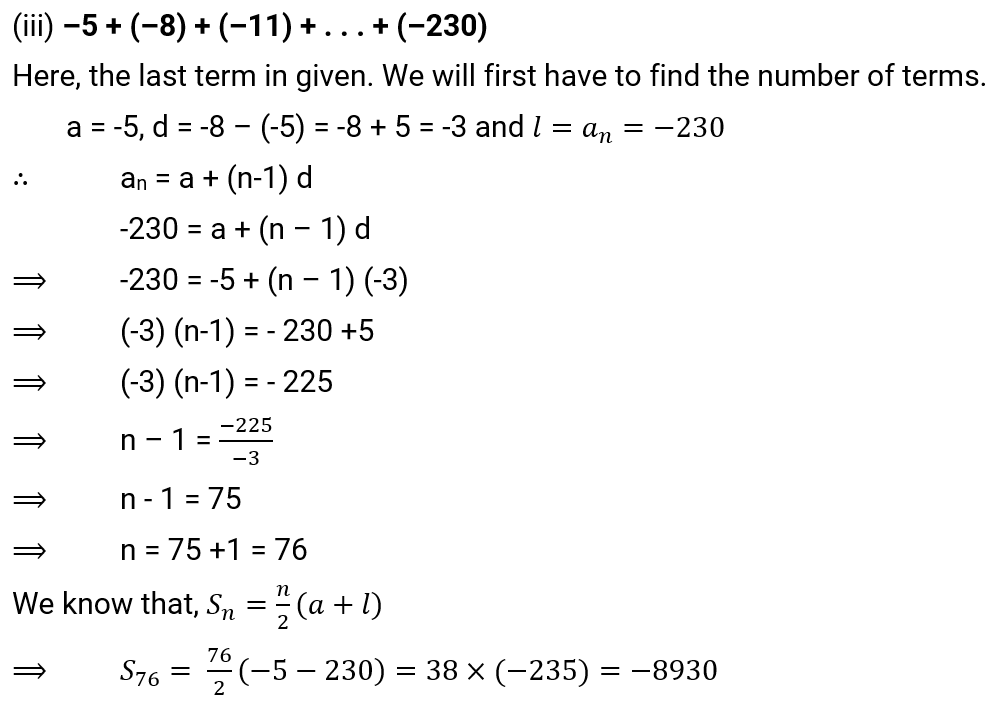
Q.3. In an AP:
(i) given a = 5, d = 3, an = 50, find n and Sn.
(ii) given a = 7, a13 = 35, find d and S13.
(iii) given a12 = 37, d = 3, find a and S12.
(iv) given a3 = 15, S10 = 125, find d and a10.
(v) given d = 5, S9 = 75, find a and a9.
(vi) given a = 2, d = 8, Sn = 90, find n and an.
(vii) given a = 8, an = 62, Sn = 210, find n and d.
(viii) given an = 4, d = 2, Sn = –14, find n and a.
(ix) given a = 3, n = 8, S = 192, find d.
(x) given l = 28, S = 144, and there is total 9 terms. Find a.
Ans:
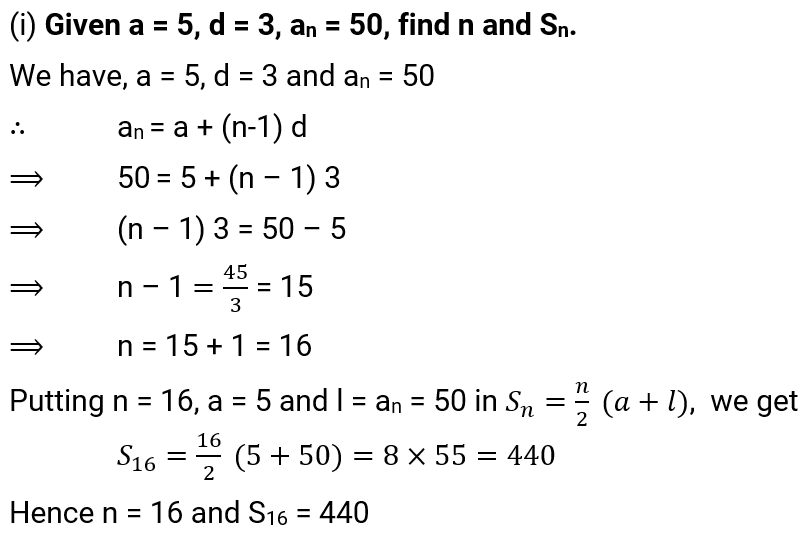
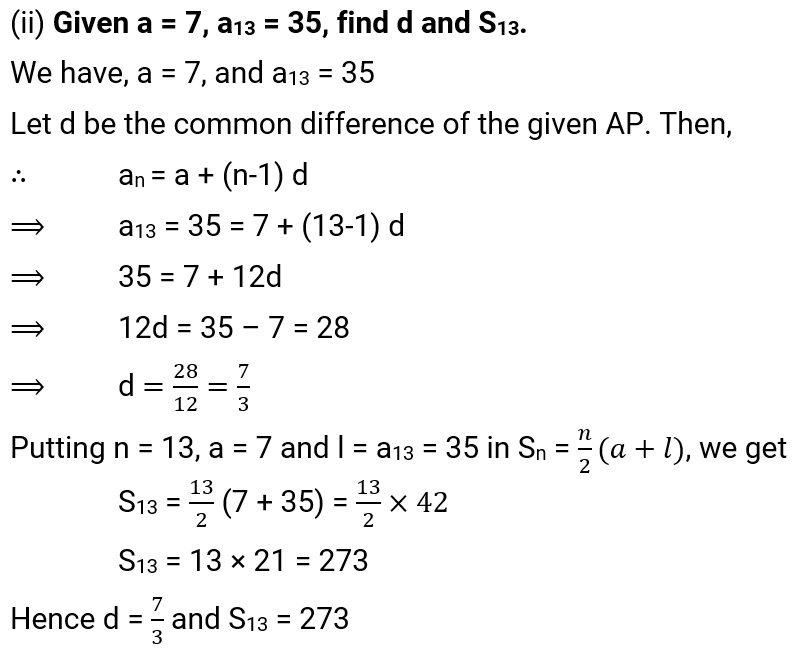
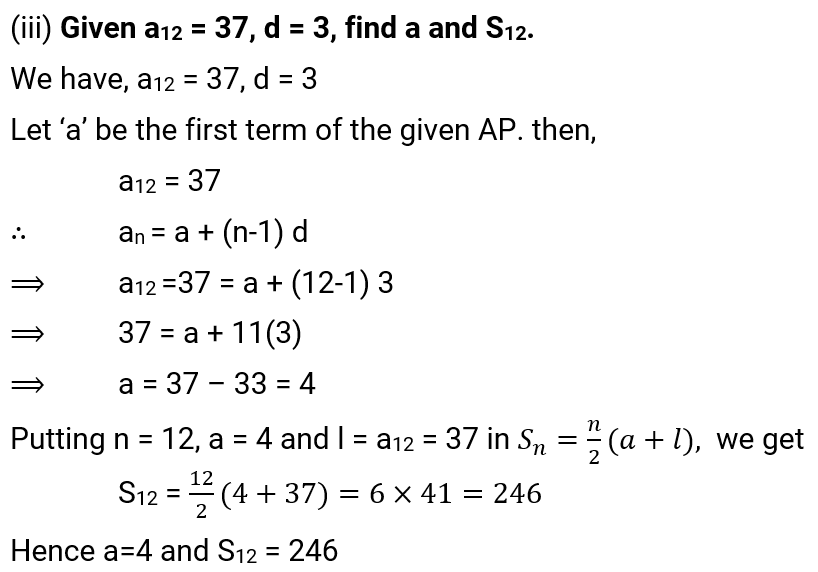
(iv) Given a3 = 15, S10 = 125, find d and a10.
We have, a3 = 15, S10 = 125
Let ‘a’ be the first term and ‘d’ the common difference of the given AP, Then,
a3 = 15 and S10 = 125
∴ an = a + (n-1) d
a3 =15 = a + (3-1) d
⟹ 15 = a + 2d ……………….. (i)
and,
∴ ${{S}_{10}}=125=\frac{10}{2}\left[ 2a+(10-1)d \right]$
125 = 5 (2a + 9d)
⟹ 5 (2a + 9d = 125
⟹ 2a + 9d = 25 …………………. (ii)
Now, multiply eq. (i) by 2 and then subtracting from eq.(ii),
2(a + 2d) – (2a + 9d) = (2×15) – 25
⟹ 4d – 9d = 30 – 25
⟹ – 5d = 5 ⟹ d = $-\frac{5}{5}$ = -1
Putting the value of d in eq. (i)
15 = a + 2d
15 = a + 2(-1)
a = 15 + 2 = 17
Now, we have, a = 17 and d = -1
∴ an = a + (n -1) d
⟹ a10 = 17 + (10-1) (-1)
⟹ a10 = 17 – 9 = 8
Hence, d = -1 and a10 = 8.
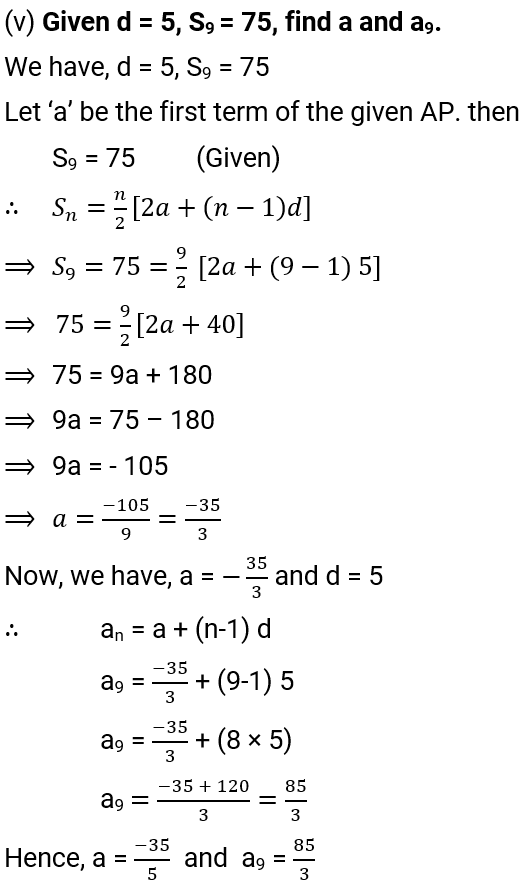
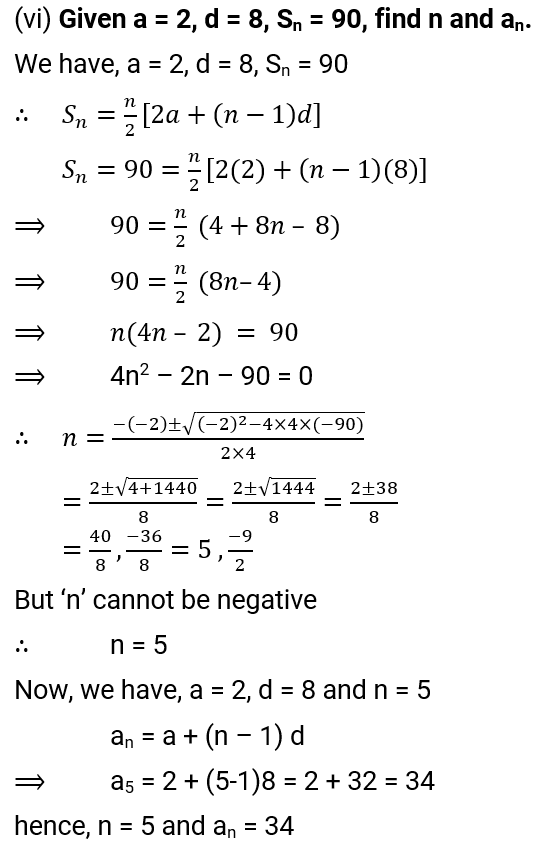
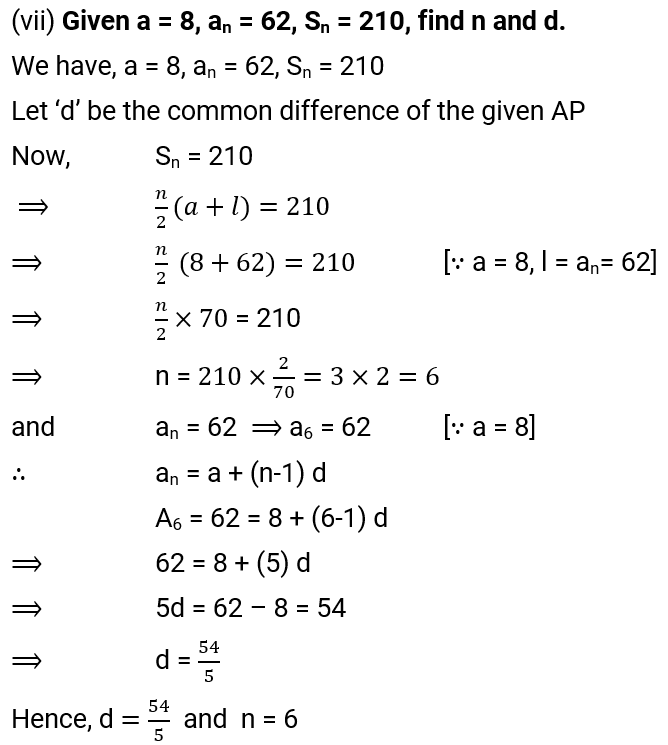
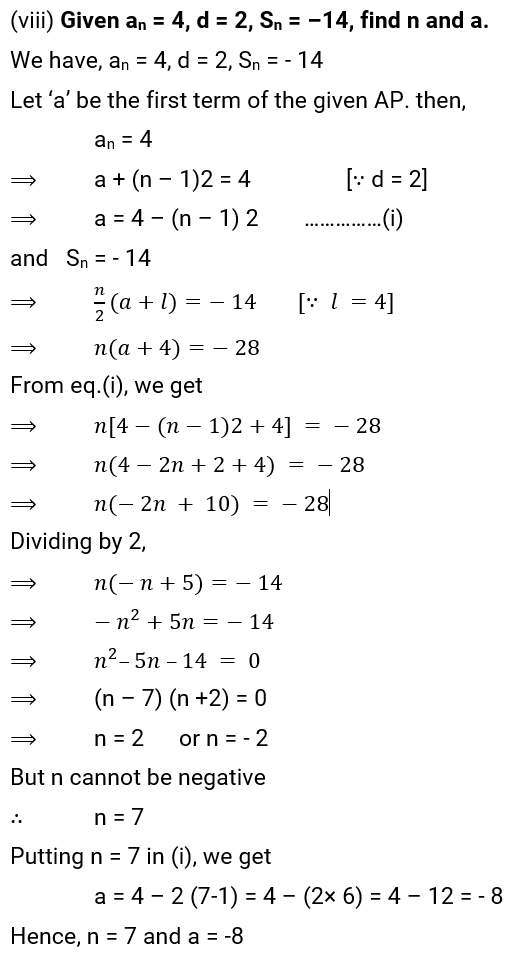
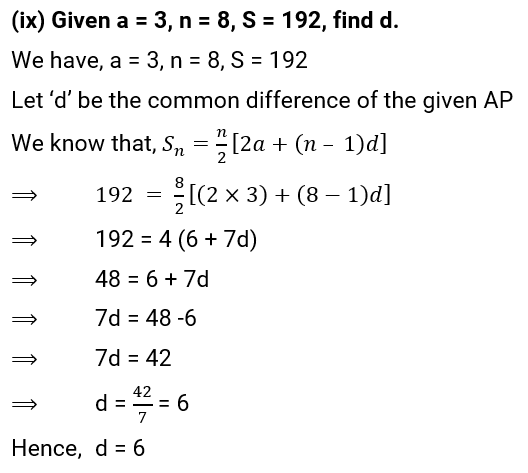
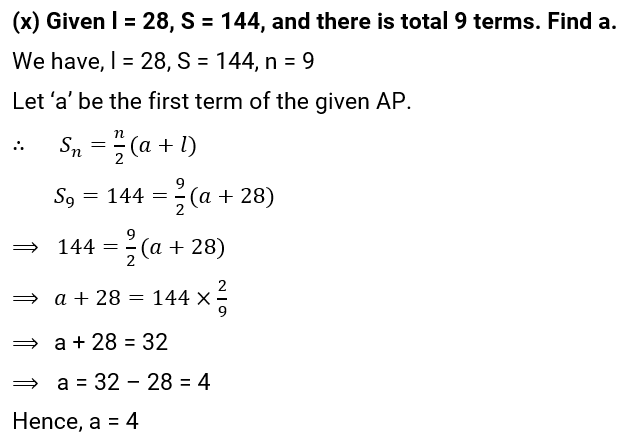
Q.4. How many terms of the AP : 9, 17, 25, . . . must be taken to give a sum of 636?
Ans:
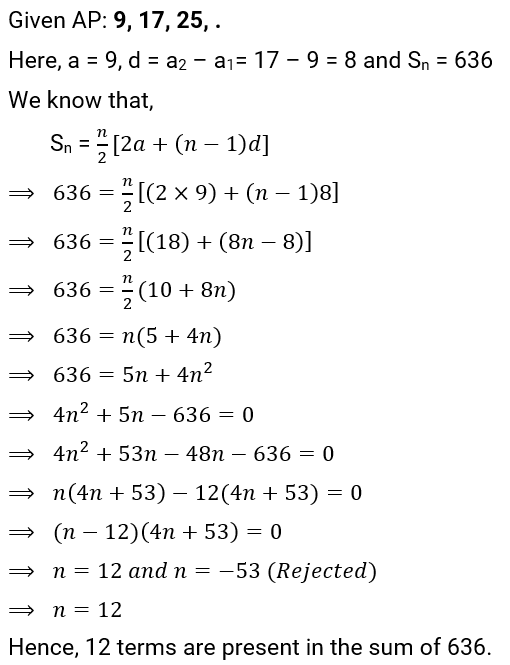
Q.5. The first term of an AP is 5, the last term is 45 and the sum is 400. Find the number of terms and the common difference.
Ans:
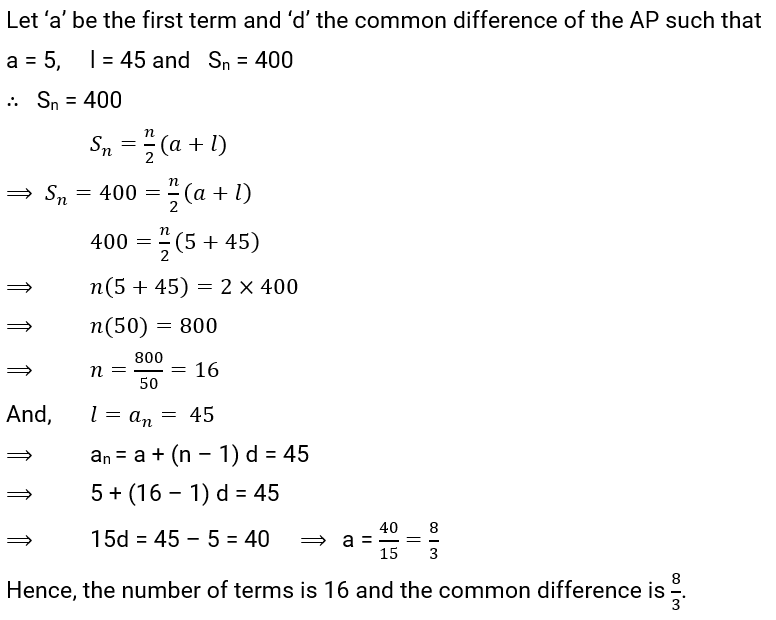
Q.6. The first and the last terms of an AP are 17 and 350 respectively. If the common difference is 9, how many terms are there and what is their sum?
Ans: Let ‘a’ be the first term and ‘d’ be the common difference. Let ‘l’ be its last term. Then, a = 17, l = an = 350, d = 9 and l = an = 350
∴ an = a + (n – 1) d
⟹ 17 + (n – 1) 9 = 350 (∵ an = 350)
⟹ 9(n – 1) = 350 – 17 = 333
⟹ n – 1 =$\frac{333}{9}$ = 37
⟹ n = 37 + 1 = 38
Putting a = 17, l = 350, n = 38 in Sn = $\frac{n}{2}$ (a + l ), we get
⟹ S38 =$\frac{38}{2}$ (17 + 350) = 19 × 367 = 6973
Hence, there are 38 terms in the AP having their sum as 6973.
Q.7. Find the sum of first 22 terms of an AP in which d = 7 and 22nd term is 149.
Ans: Let ‘a’ be the first term and ‘d’ the common difference of the given AP. then,
So, we have, d = 7 and a22 = 149
∴ an = a + (n+1) d
⟹ a + (22 – 1) 7 = 149 (∵ an = 149)
⟹ a + 21 × 7 = 149
⟹ a = 149 – 147
⟹ a = 2
Putting a = 2, n = 22 and d = 7 in Sn = $\frac{n}{2}$ (a + l ), we get
S22 = $\frac{22}{2}$ [(2×2)+(22-1)(7)]
S22 = 11 [4 +( 21× 7)]
S22 = 11 (4 + 147)
S22 = 11 × 151 = 1661
Hence, the sum of first 22 terms is 1661.
Q.8. Find the sum of first 51 terms of an AP whose second and third terms are 14 and 18 respectively.
Ans: Let ‘a’ be the first term and ‘d’ the common difference of the given AP. then,
a2 = 14 and a3 = 18 and here we need to find ‘a’.
⟹ a + d = 14 …………….. (i)
And a + 2d = 18 …………….. (ii)
Subtracting (i) from (ii), we get
⟹ (a + 2d) – (a + d) = 18 -14
⟹ a + 2d – a – d) = 4
⟹ d = 4
Putting the value of d in (i), we get
⟹ a + d = 14
⟹ a + 4 = 14
⟹ a = 10
Now, we have, a = 10 and d = 4
∴ Sn = $\frac{n}{2}$ (a + l )
⟹ S51 = [(2×10)+(51-1)4]
⟹ S51 = [20 + 50 × 4 ]
⟹ S51 = $\frac{51}{2}$ (20 + 200) = $\frac{51}{2}$x 220 = 51 x 110 = 5610
Hence, the sum of first 51 terms is 5610.
Q.9. If the sum of first 7 terms of an AP is 49 and that of 17 terms is 289, find the sum of first n terms.
Ans:
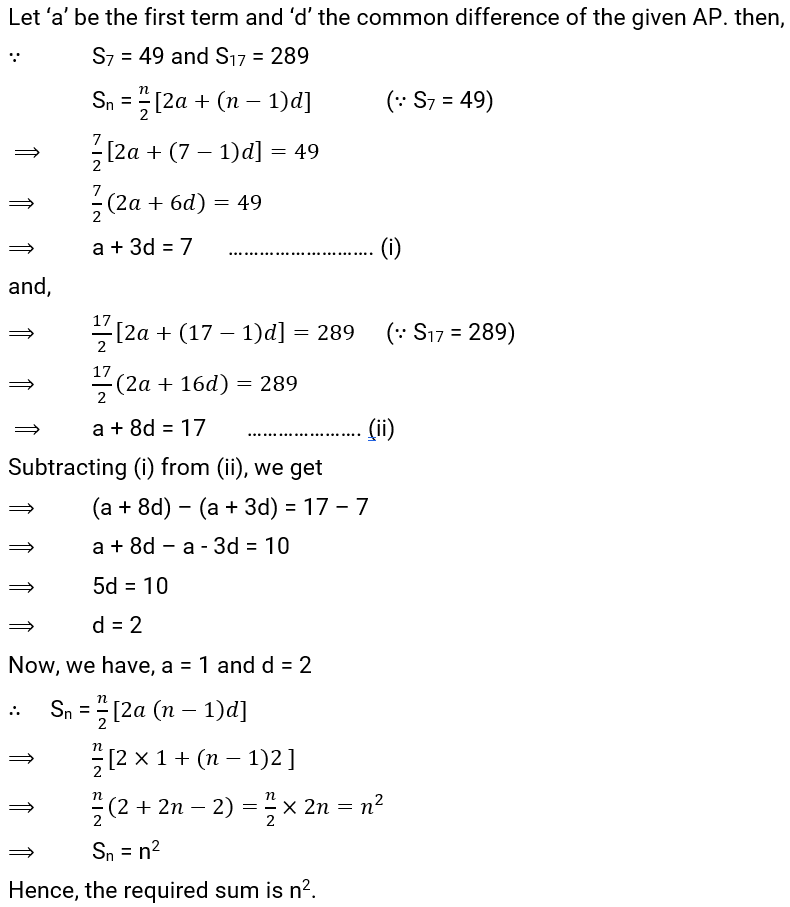
Q.10. Show that a1, a2, . . ., an, . . . form an AP where an is defined as below :
(i) an = 3 + 4n
(ii) an = 9 – 5n
Also find the sum of the first 15 terms in each case.
Ans:
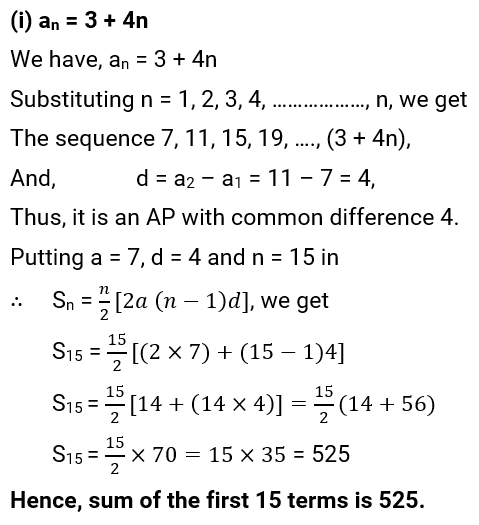
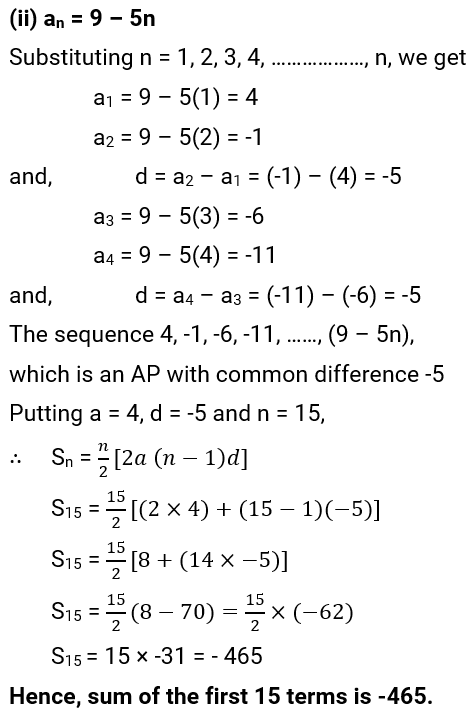
Q.11. If the sum of the first n terms of an AP is 4n – n2, what is the first term (that is S1)? What is the sum of first two terms? What is the second term? Similarly, find the 3rd, the 10th and the nth terms.
Ans: According to the question,
Sn = 4n – n2 …………… (i)
Putting n = 1 in eq.(i), we get
S1 = 4(1) – (1)2 = 4 -1 = 3
Now, S1 = a1 = 3 (First term)
Putting n = 2 in eq.(i), we get
S2 = 4(2) – (2)2 = 8 – 4 = 4
Now, a2 = S2 – S1 = 4 – 3 = 1 (Second term)
Putting n = 3 in eq.(i), we get
S3 = 4(3) – (3)2 = 12 – 9 = 3
Now, a3 = S3 – S2 = 3 – 4 = – 1 (third term)
Now, to calculate 10th term, we need to know sum of 9th term,
Putting n = 9 in eq.(i), we get
S9 = 4(9) – (9)2 = 36 – 81 = -45
Similarly, putting n = 10 in eq.(i), we get
S10 = 4(10) – (10)2 = 40 – 100 = – 60
Now, a10 = S10 – S9 = (- 60) – (- 45) = – 15 (tenth term)
Here, common difference, d = an – a(n-1)
Let say, d = a3 – a2 = (-1) – (1) = -2
∴ nth term, an = a+(n-1) d
an = 3 +(n-1) (-2)
an = 3 +(-2n + 2)
an = 5 – 2n
Q.12. Find the sum of the first 40 positive integers divisible by 6.
Ans: The first positive integers divisible by 6 are 6, 12, 18, …., Clearly, it is an AP with first term a = 6 and common difference d = 6. We want to find, S40.
∴ Sn = $\frac{n}{2}$ [2a + (n – 1)d]
⟹ S40 = $\frac{40}{2}$ [(2 × 6) + (40 –1)6]
⟹ S40 = 20[12 + (39 × 6)] = 20 (12 + 234)
⟹ S40 = 20 × 246
⟹ S40 = 4920
Hence, sum of the first 40 positive integers divisible by 6 is 4920.
Q.13. Find the sum of the first 15 multiples of 8.
Ans: The first 15 multiples of 8 are (8×1), (8×2), (8×3), ……., (8×15) i.e., 8, 16, 24, ……120,
It is an AP in which a = 8 and d = a2 – a1 = 16 – 8 = 8
We know that,
${{S}_{n}}=\frac{n}{2}(a+l)$
∴ ${{S}_{15}}=\frac{15}{2}(8+120)$ (∵l = an =120)
${{S}_{15}}=\frac{15}{2}\times 128$
S15 = 15 × 64 = 960
Hence, the sum of the first 15 multiples of 8 is 960.
Q.14. Find the sum of the odd numbers between 0 and 50.
Ans: The odd numbers between 0 and 50 are 1, 3, 5,… 49. They form an AP and there are 25 terms.
Here, a = 1, n = 25 terms and l = an = 49
∴ ${{S}_{n}}=\frac{n}{2}(a+l)$
${{S}_{25}}=\frac{25}{2}(1+49)$ (∵ l = an = 49)
${{S}_{25}}=\frac{25}{2}\times 50=\,25\times 25=625$
Hence, the sum of the odd number between 0 and 50 is 625.
Q.15. A contract on construction job specifies a penalty for delay of completion beyond a certain date as follows: ₹200 for the first day, ₹ 250 for the second day, ₹ 300 for the third day, etc., the penalty for each succeeding day being ₹ 50 more than for the preceding day. How much money the contractor has to pay as penalty, if he has delayed the work by 30 days?
Ans: penalty of the first day = ₹ 200
penalty of the second day = ₹ (200 + 50) = ₹ 250
penalty of the third day = ₹ (200 + 50 + 50) = ₹ 300
the list is ₹ 200, ₹ 250, ₹ 300 …..
Here, a = 200, d = a2 – a1= 250 – 200 = 50 and n = 30 terms (= Days)
∵ ${{S}_{n}}=\frac{n}{2}\left[ 2a+(n-1)d \right]$
∴ ${{S}_{30}}=\frac{30}{2}\left[ (2\times 200)+(30-1)50 \right]$
S30 =15 [400 + (29 ×50)]
S30 = 15 (400 +1450) = 15 × 1850 = 27750
Hence, a delay of 30 days costs the contractor Rs 27,750
Q.16. A sum of ₹ 700 is to be used to give seven cash prizes to students of a school for their overall academic performance. If each prize is ₹ 20 less than its preceding prize, find the value of each of the prizes.
Ans:
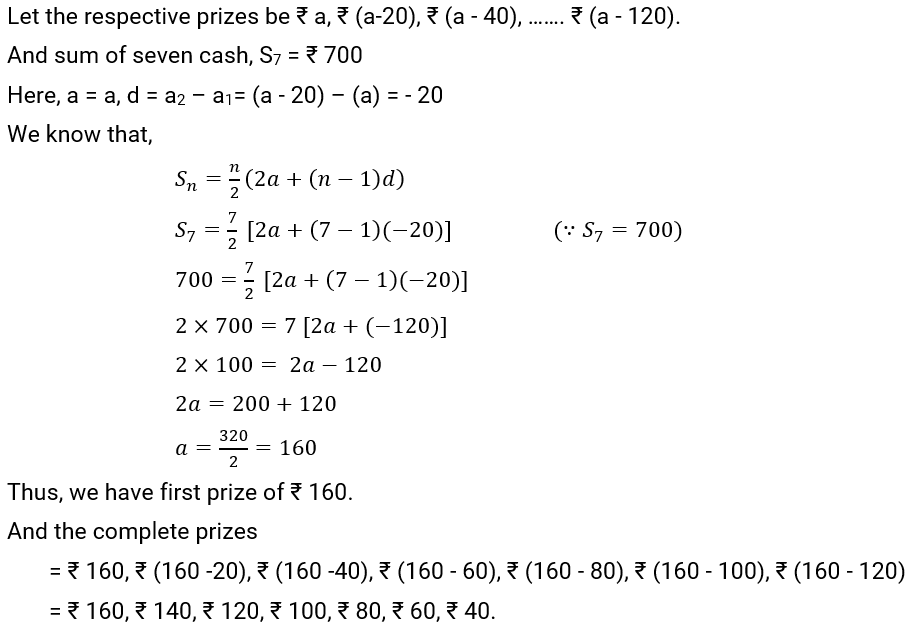
Q.17. In a school, students thought of planting trees in and around the school to reduce air pollution. It was decided that the number of trees, that each section of each class will plant, will be the same as the class, in which they are studying, e.g., a section of Class I will plant 1 tree, a section of Class II will plant 2 trees and so on till Class XII. There are three sections of each class. How many trees will be planted by the students?
Ans: Since there are three sections of each class; so
The number of trees planted by class -I = 1 x 3 = 3
The number of trees planted by class -II = 2 x 3 = 6
The number of trees planted by class – III = 3 x 3 = 9
The number of trees planted by class -IV = 4 x 3 = 12
Similarly, the number of trees planted by class – XII = 12 x 3 = 36
Now, we have the list of trees planted = 3, 6, 9, 12, ……….. 36
it is an AP in which a = 3, d = a2 – a1= 6 – 3 = 3, n = 12 and l = 36
we know that,
${{S}_{n}}=\frac{n}{2}(a+l)$
${{S}_{12}}=\frac{12}{2}(3+36)$
S12 = 6(39) = 234
Hence, the sum of the number of the trees planted by these classes are 234.
Q.18. A spiral is made up of successive semicircles, with centers alternately at A and B, starting with centre at A, of radii 0.5 cm, 1.0 cm, 1.5 cm, 2.0 cm, . . . as shown in Fig. 5.4. What is the total length of such a spiral made up of thirteen consecutive semicircles? (Take $\pi =\frac{22}{7}$)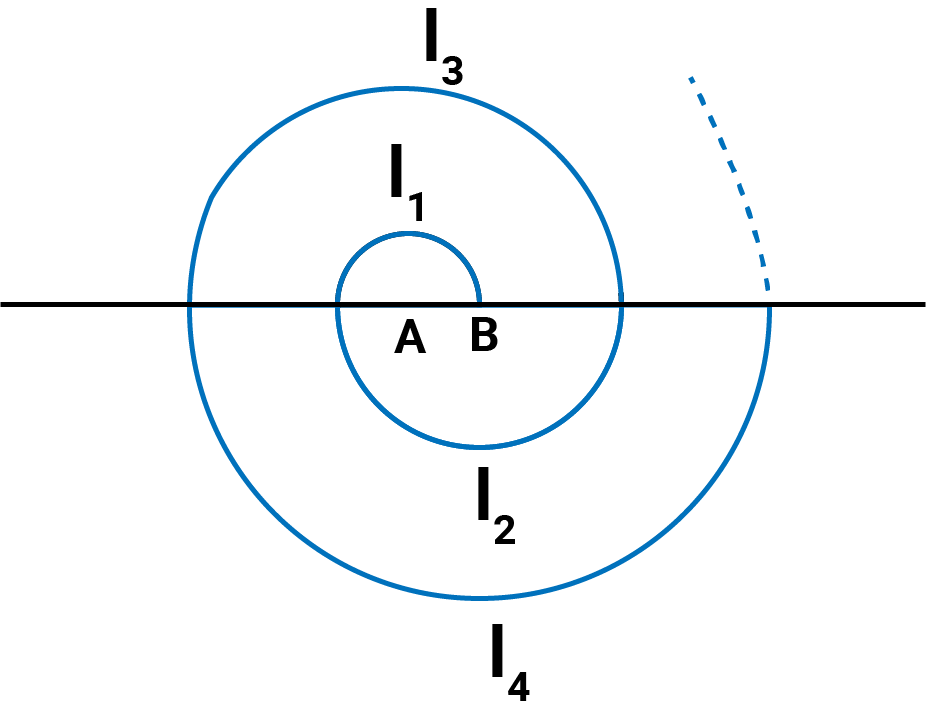
Ans:
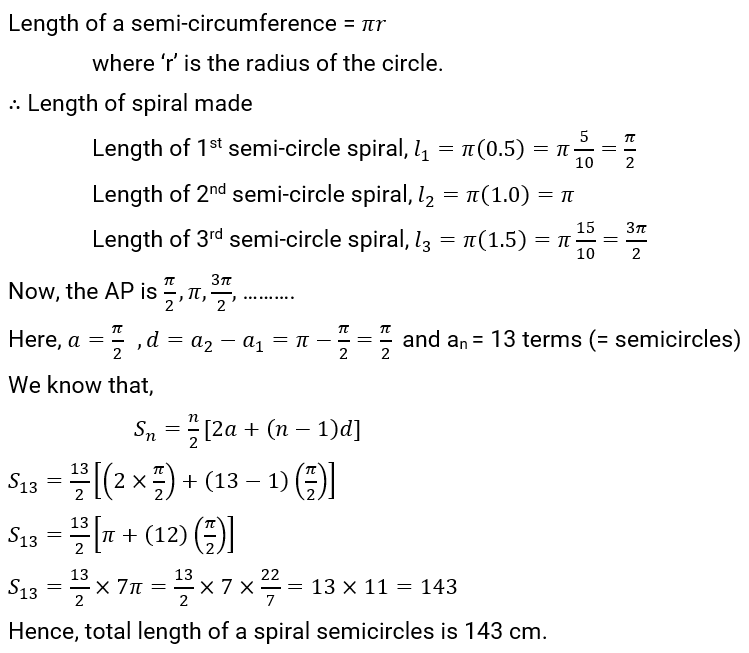
Q.19. 200 logs are stacked in the following manner: 20 logs in the bottom row, 19 in the next row, 18 in the row next to it and so on (see Figure). In how many rows are the 200 logs placed and how many logs are in the top row?

Ans:
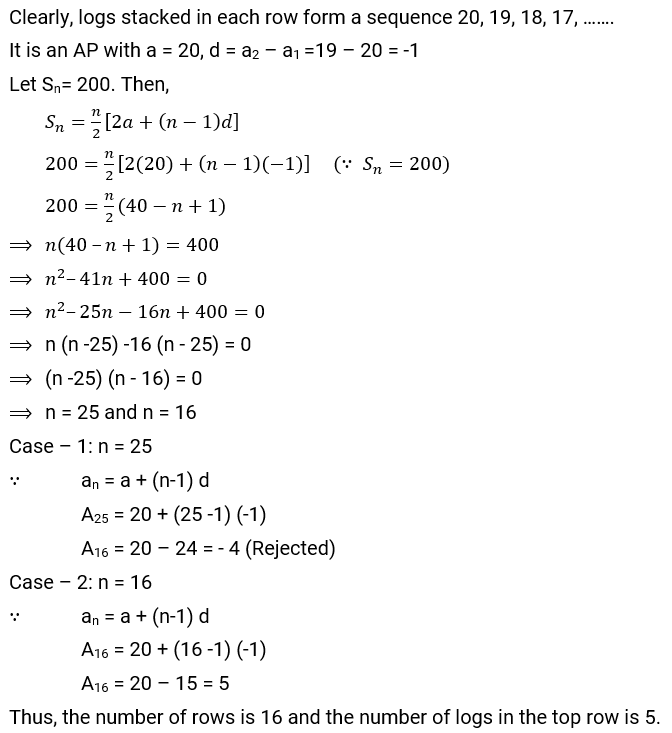
Q.20. In a potato race, a bucket is placed at the starting point, which is 5 m from the first potato, and the other potatoes are placed 3 m apart in a straight line. There are ten potatoes in the line (see Figure).

A competitor starts from the bucket, picks up the nearest potato, runs back with it, drops it in the bucket, runs back to pick up the next potato, runs to the bucket to drop it in, and she continues in the same way until all the potatoes are in the bucket. What is the total distance the competitor has to run?
Ans: To pick up the first potato, second potato, third potato, fourth potato, …
The distances (in meters) run by the competitor to pick –
First potato = 2 x 5 = 10 m
Second potato = 2 x (5 + 3) = 16 m
Third potato = 2 x (5 + 3 +3) = 22 m
Fourth potato = 2 x (5 + 3 + 3 + 3) = 28 m
It is in AP with a = 10, d = 16 -10 = 6 and n = 10 terms (= potatoes)
∴ The sum of first ten terms
S10 = $\frac{10}{2}$ [(2×10) + (10 –1) × 6]
S10 = 5 (20 + 54) = 5 × 74 = 370
∴ The total distance the competitor has to run is 370 m.
Download: NCERT Books

